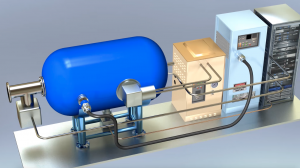Superconducting radio-frequency (SRF) cavities enable accelerators to generate high-energy beams over short distances. With SRF cavities, it is possible to build compact linear accelerators — less than 1.5 meters in length — that can accelerate electron beams beyond 10 MeV, with average beam powers in the tens of kilowatts. Such compact SRF accelerators can have high wall-plug power efficiencies and require smaller radiation enclosures, reducing overall installation costs.
The centerpiece of the IARC strategy is a technology roadmap that will lead to the development of a compact, high-power industrial electron accelerator, thus enabling mobile and field-deployed applications of electron beams for many existing and proposed industrial applications.
Several recent breakthroughs in superconducting radio-frequency (SRF) technologies hold the key for enabling this new technology:
- High-temperature superconductors and new processing technologies for SRF cavities make it possible to achieve higher cavity quality factors at higher temperatures (4 kelvin), improving efficiency and reliability, while dramatically lowering cryogenic losses.
- Conduction cooling greatly simplifies the cryostat, the containment vessel that maintains the appropriate operating temperature for the accelerator, and significantly reduces the costs of fabrication and assembly. Commercial cryocoolers, with higher capacity at 4 kelvin, reduce the costs and complexity of cryogenics.
- New RF power technologies, such as the Fermilab-invented injection-locked magnetron, allow for phase and amplitude control at a much lower cost per watt to generate and control radio waves in accelerators.
- Low-loss RF power couplers reduces the electromagnetic losses and thus reduces cryogenic load, thus increasing the efficiency of the accelerator operation
- Electron guns integrated into the accelerator are made possible through the use of field emission cathodes, thus reducing complexity.
More Information:
Bringing compact particle accelerators to industry
Particle accelerators have many uses in industrial settings. To advance a new type of compact particle accelerator, the U.S. Department of Energy has awarded funding to Charles Thangaraj, a senior scientist at the DOE’s Fermi National Accelerator Laboratory. He and his colleagues are developing devices called cathodes that will generate electrons to be propelled with Fermilab superconducting radio frequency technologies.


